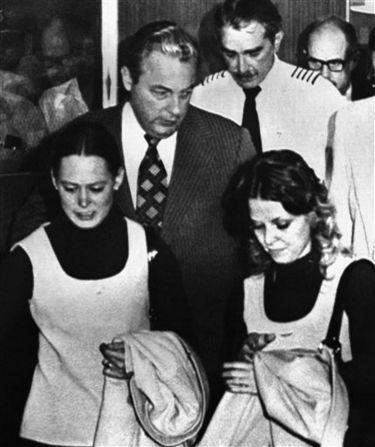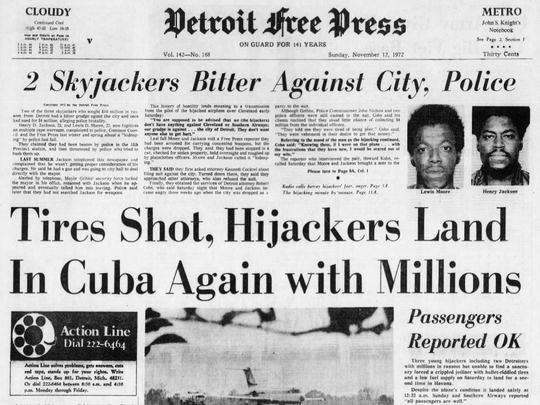Southern Airways Flight 49
Southern Airways Flight 49 was an epic aircraft hijacking which occurred on November 10, 1972 aboard a Southern Airways flight from Birmingham Municipal Airport.
The two-engine DC-9 craft took off from Birmingham at 6:30 PM en route to Florida via Montgomery's Dannelly Field Airport. Shortly afterward passengers Henry Jackson, Lewis Moore and Melvin Cale, all from Detroit, Michigan, produced handguns and a fake handgrenade. They had concealed the weapons in an overcoat which they passed back and forth during the airline's searches prior to boarding.
The men ordered the male passengers on board to strip to their shorts and demanded that pilot William Haas turn toward Detroit and to make a refueling stop in Jackson, Mississippi. They also demanded a $10 million cash payment from the city in return for not harming their 34 hostages.
Southern Airways and the Detroit City Council each dispatched $500,000 to the Detroit airport, where local officials were in negotiations with the hijackers by radio. The hijackers refused to land in Detroit, however, and ordered the pilot to continue over Lake Erie to Cleveland, Ohio and then to land in Toronto, Ontario, where they refused the smaller offer. The three ordered the pilot to return to the air and directed him to Knoxville, Tennessee. On the way, they raided the liquor cabinet and shared the contents with passengers.
During this leg, the aircraft was followed by a Southern Airways Learjet and another DC-9, as well as by a Navy Reserve plane with FBI agents on board. As they neared Tennessee, the hijackers threatened to crash the plane into the Oak Ridge National Laboratory, a nuclear energy research facility. They held a gun to Haas' head and ordered him toward the target until they heard from Nixon adviser John Ehrlichman that the ransom would be paid.
Instead they ordered the plane to refuel in Lexington, Kentucky, then landed in Chattanooga where they received a mail bag stuffed with $20 bills. Authorities said that it was the $10 million requested, but only $2 million had actually been provided by the airline. They also demanded and received ten parachutes, seven bulletproof vests, seven crash helmets, some medical supplies, fifty airline meals and several large canvas bags. Instead of releasing their hostages, though, the hijackers ordered the plane into the air again for a flight to Havana, Cuba.
During the final flight, the hijackers distributed their loot to the passengers. After failed negotiations on the ground at José Martí terminal in Cuba, the hijackers returned the plane to the air, and ordered Haas to fly to Europe. He explained that the aircraft could not make that trip, so instead they headed for Key West, and then McCoy Air Force Base in Orlando, Florida for another re-fueling. On the airstrip there, the hijackers demanded to speak to President Nixon. FBI agents, under orders from Acting Director L. Patrick Gray, fired at the aircraft's tires to prevent it from making another ascent.
The hijackers reacted by shooting copilot Harold Johnson in the arm. Johnson said he was ordered to stand and was shot as an example. Moore claimed it was an accidental shooting. At the hijacker's order, Haas managed to get the aircraft aloft again, despite the damaged tires, and returned to Havana where he landed safely. Cuban soldiers arrested the hijackers and confiscated the cash, including the bills distributed among the passengers. The passengers and crew were returned to Miami.
The incident led to changes in airport security measures, and also led Cuba to agree to a limited dialog with the United States on how to prevent future hijackings. On January 5, 1973 the Federal Aviation Administration ordered hand-held metal detectors and armed guards at all passenger searches. The measures were effective in stopping the spate of airline hijackings. Jackson, Moore and Cale spent eight years in a Cuban prison before being extradited to the United States, where they remained imprisoned.
The three hijackers faced trial in U.S. District Court in Birmingham in February 1981. Jackson was sentenced to 25 years and Moore and Cale to 20 years each. Cale was paroled in 1993 but was arrested shortly afterwards when he and an accomplice robbed a bank in Chattanooga, Tennessee. Moore was released in 1998.
Interviewed in the Detroit Free Press, Moore claimed that his crime was motivated by a desire to publicize police brutality and injustice. He said that the Detroit police were threatening to falsify rape charges against him and disfigure his wife, and bring harm to his two young sons because he had filed a lawsuit against the department and spoken out in the press about brutality. In fact, after the hijacking incident, Detroit police did accuse Moore and Jackson of involvement in "a string of assaults" against women, including nine rapes.
The four crew members of Southern Airways Flight 49, William Haas, Harold Johnson, Donna Holman, and Karen Chambers, were presented with Keys to the City by Birmingham mayor George Seibels during a dinner at the Admiral Benbow Inn on May 21, 1973.
The story of the hijacking and the motivations of its perpetrators was the subject of the premiere episode of the National Geographic Channel series "I Am Rebel".
References
- "2 Skyjackers Bitter Against City, Police." (November 12, 1972) Detroit Free Press
- "Tires Shot, Hijackers Land in Cuba Again With Millions." (November 12, 1972) Detroit Free Press
- "Terror on Flight 49" (November 27, 1972) TIME magazine
- Skinner, Franklin (May 22, 1973) "Crew in Southern hijack returns to city." Birmingham Post-Herald, p. 17
- "Hijacking of flight to Montgomery led officials to overhaul security at airports" (October 1, 2001) The Tuscaloosa News
- Blair, Ed & William R. Haas (2006) Odyssey of Terror: Flight 49. self-published. ISBN 1475078447
- Robert, Allan (June 6, 2016) "[http://www.freep.com/story/news/local/michigan/detroit/2016/06/06/detroit-skyjacker-airplane-explanation/85314438/ Ex-Detroiter behind infamous 1972 skyjacking tells his story." Detroit Free Press

